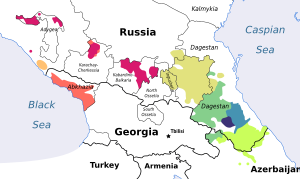| Circassian | |
|---|---|
| Cherkess | |
| Geographic distribution | North Caucasus |
| Ethnicity | Circassians, Cherkesogai |
| Linguistic classification | Northwest Caucasian
|
| Proto-language | Proto-Circassian |
| Subdivisions | |
| Language codes | |
| Glottolog | circ1239 |
 Circassian | |
Circassian (/sɜːrˈkæʃən/ sur-KASH-ən), also known as Cherkess (/tʃɜːrˈkɛs/ chur-KESS), is a subdivision of the Northwest Caucasian language family, spoken by the Circassian people. There are two Circassian languages, defined by their literary standards, Adyghe (кӀахыбзэ; also known as West Circassian), with half a million speakers, and Kabardian (къэбэрдейбзэ; also known as East Circassian), with a million. The languages are highly mutually intelligible with one another, but differ to a degree where they would be considered clear-cut dialects. The earliest extant written records of the Circassian languages are in the Arabic script, recorded by the Turkish traveller Evliya Çelebi in the 17th century,[1] although the Greek and Georgian alphabets were adapted for them in ancient and medieval times.[2]
There is consensus among the linguistic community about the fact that Adyghe and Kabardian are typologically distinct languages.[3][4][5] However, the local terms for these languages refer to them as dialects. The Circassian people call themselves адыгэ (adyge; English: Adyghe) in their native language. In the southwestern part of European Russia, there is also a Federal Subject called Adygea (Russian: Адыгея, Adygeya), enclaved within Krasnodar Krai, which is named after the Circassian endonym. In the Russian language, the Circassian subdivision is treated as a group of languages and called адыгские (adygskie, meaning the Adyghe languages), whereas the Adyghe language is called адыгейский (adygeyskiy, meaning the language of those in [the Republic of] Adygea). The terms Circassian and Cherkess are sometimes used in several languages as synonyms for the Northwest Caucasian languages in general or the Adyghe language in particular.
- ^ Papşu, Murat (2006)."Çerkes-Adığe yazısının tarihçesi Archived December 14, 2013, at the Wayback Machine". Nart, İki Aylık Düşün ve Kültür Dergisi, Sayı 51, Eylül-Ekim 2006. (in Turkish)
- ^ "The Circassian Alphabet". circassianweb.com. Circassian Family Tree. Retrieved 24 March 2024.
- ^ Kuipers, Aert H. (1960). Phoneme and morpheme in Kabardian (eastern Adyghe). The Hague: Mouton & Co. p. 7.
- ^ Smeets, Henricus Joannes (1984). Studies in West Circassian phonology and morphology. Leiden: The Hakuchi Press. p. 41. ISBN 90-71176-01-0.
- ^ Hewitt, George (2005). "North West Caucasian". Lingua. 115 (1–2): 17. doi:10.1016/j.lingua.2003.06.003. Retrieved 16 April 2017.